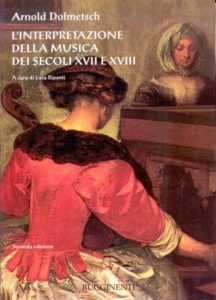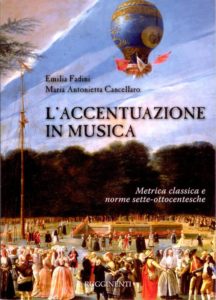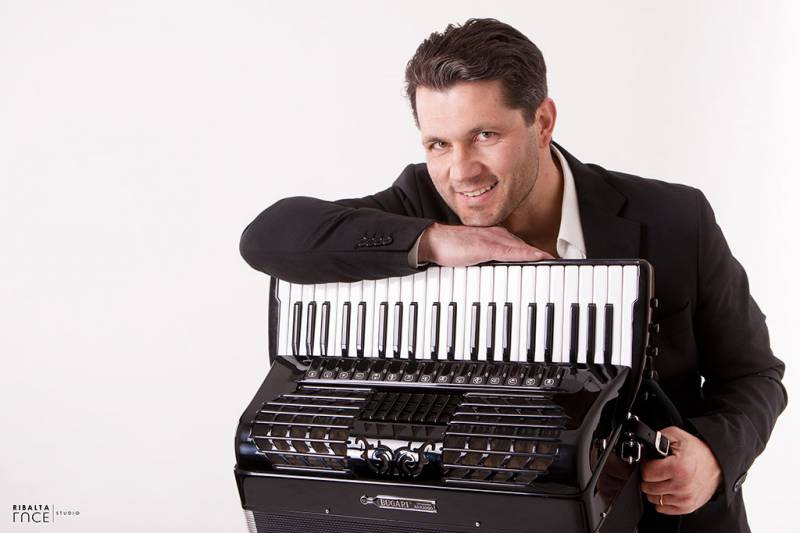Giorgio Dellarole: musica antica per uno strumento moderno – 2 (English version of this article)
LE FONTI
Ho parlato, nel mio intervento introduttivo, della fondamentale importanza della conoscenza per l’interpretazione del repertorio antico e vorrei avviare adesso il lungo percorso, che caratterizzerà un buon numero di articoli, dedicato all’analisi degli elementi teorici da prendere in considerazione.
Un elenco sommario delle fonti di informazione potrebbe comprendere, a mio parere, i seguenti punti:
- I documenti antichi
- I documenti moderni
- Il contesto storico e sociale europeo del Sei-Settecento
- La tecnica e le caratteristiche degli strumenti originali
 Parto dall’ultimo punto dell’elenco per chiarire che non ritengo necessario saper suonare il clavicembalo per eseguire una Sonata di Scarlatti sulla fisarmonica e non penso neanche che si debbano conoscere gli strumenti antichi solo per tentare di imitarne pedissequamente le articolazioni e le sonorità, quasi a voler espiare la colpa di utilizzare una tastiera moderna castrandone le possibilità dinamiche ed espressive. Credo semplicemente che sia d’aiuto capire cosa si possa fare o non fare sullo strumento storico per poter adattare in maniera più consapevole i brani al proprio strumento.
Parto dall’ultimo punto dell’elenco per chiarire che non ritengo necessario saper suonare il clavicembalo per eseguire una Sonata di Scarlatti sulla fisarmonica e non penso neanche che si debbano conoscere gli strumenti antichi solo per tentare di imitarne pedissequamente le articolazioni e le sonorità, quasi a voler espiare la colpa di utilizzare una tastiera moderna castrandone le possibilità dinamiche ed espressive. Credo semplicemente che sia d’aiuto capire cosa si possa fare o non fare sullo strumento storico per poter adattare in maniera più consapevole i brani al proprio strumento.
Ho già parlato, nel primo articolo, della legittimità di una riproposizione del repertorio barocco sul pianoforte o sulla fisarmonica e del favore che questo tipo di operazione incontra sempre più spesso tra gli specialisti e voglio aggiungere che l’idea di eseguire uno stesso brano su differenti strumenti ha radici molto profonde e fa parte del concetto stesso di musica barocca. Per i musicisti dell’epoca la riproposizione di un brano non ne impoveriva il significato, ma, al contrario, ne riconfermava la validità.
È documentato l’utilizzo alternativo del violino e del mandolino, che condividono anche l’accordatura, in ambito romano all’inizio del Settecento e del violino e del cornetto o del violino e del flauto traversiere durante tutto il Barocco, così come testimoniato dalle molte raccolte che nell’intestazione offrono la scelta (1) e conosciamo un gran numero di opere con una destinazione strumentale piuttosto ampia (2).
Non voglio negare che, al contrario, molti brani avessero un riferimento strumentale preciso, ma le molteplici testimonianze della “promiscuità” diffusa ci fanno pensare che spesso le esigenze pratiche prevalessero su quelle filologiche.
A proposito del terzo punto dell’elenco (il contesto storico e sociale) devo confessare di essere un amante dell’interdisciplinarietà e di essere convinto che la conoscenza, pure molto dettagliata, di una composizione spesso non sia sufficiente ad una comprensione profonda della stessa se manca la consapevolezza di ciò che le sta intorno. Come capire l’opera di Bach se non si conosce la Riforma protestante o la musica di Lully senza considerare il suo rapporto privilegiato con Luigi XIV e la vocazione celebrativa della sua opera verso il potere del Re Sole? Quanto più profonda può essere la comprensione della musica barocca se si conosce il Barocco in architettura e nelle arti figurative? Più in generale penso che la formazione del musicista moderno e ancora di più del fisarmonicista (3), non possa ridursi agli aspetti tecnici e strumentali, ma debba comprendere un bagaglio culturale adeguato.
 Con la definizione “documenti moderni” mi riferisco a tutti i testi recenti che trattano dei diversi aspetti legati all’analisi del repertorio antico. Per il neofita queste risorse possono essere più importanti dei documenti originali che, a causa del linguaggio utilizzato e della particolare impostazione, possono risultare incomprensibili se mancano i riferimenti culturali necessari.
Con la definizione “documenti moderni” mi riferisco a tutti i testi recenti che trattano dei diversi aspetti legati all’analisi del repertorio antico. Per il neofita queste risorse possono essere più importanti dei documenti originali che, a causa del linguaggio utilizzato e della particolare impostazione, possono risultare incomprensibili se mancano i riferimenti culturali necessari.
Se si vuole ricostruire la storia moderna della filologia musicale si può partire dai testi dei “pionieri” e in particolare da “L’interpretazione della musica dei secoli XVII e XVIII” (4) di Arnold Dolmetsch del 1915 che avviò il movimento dell’early music nel XX secolo. Importanti sono anche i testi di Manfred Bukofzer (5), Thurston Dart (6), Robert Donington (7), Antoine Geoffroy-Dechaume (8) e gli interventi critici di Richard Taruskin contro la “dottrina autenticista” raccolti nel volume “Text and Act: Essays on Music and Performance” (1995).
Bisogna dire che, alla luce dell’enorme sviluppo della ricerca filologica a partire dalla seconda parte del XX secolo, i testi citati possono risultare piuttosto datati e contengono una serie di inesattezze poi rettificate dalla critica moderna, anche se restano dei capisaldi della filologia e possiedono una grande valenza culturale.
Esistono fortunatamente anche dei lavori più recenti che in parte si basano sui documenti originali e in parte utilizzano e approfondiscono le ricerche precedenti. Ho citato nel primo articolo “Il clavicembalo” di Bellasich-Fadini-Granziera-Leschiutta e vado ora ad elencare una serie di testi che possono aiutare nell’approccio alle problematiche interpretative poste dal repertorio antico. Naturalmente l’elenco non intende e non potrebbe in ogni caso, esaurire l’argomento.
- Emilia Fadini – Maria Antonietta Cancellaro: L’accentuazione in musica. Metrica classica e norme sette-ottocentesche (2009)
Testo di grandissima attualità, dedicato all’accentuazione nella prassi esecutiva settecentesca alla luce delle norme redatte nel XVIII secolo e nei primi decenni del XIX. Molto interessante il parallelo tra modalità di organizzazione della frase musicale e metrica poetica
- John Rink: L’esecuzione musicale. Guida, analisi e prospettive (2002)
Raccolta di sedici saggi sui molteplici aspetti dell’esecuzione musicale. Tratta l’argomento analizzando l’atto del “fare musica” e tutte le problematiche connesse: l’esecuzione musicale attraverso le epoche, la storia dell’insegnamento, l’apprendimento e la memorizzazione, il problema dell’interpretazione e della fedeltà alla partitura nei secoli, l’ascolto
- Paul Brunold: Traité des signes et agréments (1964)
Testo molto importante che tratta degli abbellimenti nel repertorio clavicembalistico francese del XVII e XVIII secolo (9). Brunold, musicologo e organista francese, riunisce le informazioni presenti nelle tavole che spesso accompagnavano le composizioni francesi, ripropone le tavole stesse, le integra e le chiarisce se necessario
- Nunziata Bonaccorsi: L’ornamentazione ovvero l’arte di abbellire in musica (2002)
Libro preziosissimo che rende accessibili a tutti le informazioni sull’ornamentazione contenute in trattati molto complessi o poco conosciuti o non tradotti in italiano. Analizza l’argomento con riferimento ai grandi filoni storico-stilistici: la scuola italiana, francese, tedesca, spagnola e inglese e termina con due appendici dedicate ai singoli abbellimenti e alle testimonianze di vari autori sull’argomento
- Ernst Ferand: Die Improvisation in der Musik (1938)
Lo studio dell’improvvisazione nella musica colta occidentale inizia con l’opera di Ferand che, per primo, intuì l’importanza dell’improvvisazione e la necessità di dare piena dignità all’analisi storica e metodologica dei processi esecutivi estemporanei
- Orchidea Salvati: Processo al doppio punto – Raccolta di scritti sul problema del punto di valore (1989)
Raccoglie una serie di saggi, scritti tra il 1965 e il 1981, su una delle questioni cruciali relative alla prassi esecutiva barocca: il prolungamento del punto. Attualmente l’argomento non è più così controverso, ma il libro merita comunque una lettura per la ricchezza di citazioni e di accurati riferimenti storici
- Stuart Isacoof: Temperamento – Storia di un enigma musicale (2001)
Affronta un altro degli argomenti cardine del dibattito sul repertorio antico: il temperamento. La teoria di base dell’autore che vede nel temperamento equabile il vertice del progresso e della ricerca è alquanto opinabile, ma, come e più del precedente, il libro è ricchissimo di aneddoti curiosi e di informazioni interessanti
- Early Music:
Per restare aggiornati sulle scoperte e sugli studi più recenti riguardanti il repertorio antico, consiglio di sottoscrivere un abbonamento a “EarlyMusic” (10). In questo modo si possono ricevere i quattro numeri annuali della pubblicazione e si acquisisce il diritto di consultare l’archivio storico della rivista, alla quale hanno collaborato tutte le più grandi personalità del XX secolo
Concludo qui il mio secondo articolo che, spero, sia gradito e utile agli amici di strumentiemusica.com. L’analisi dei documenti antichi inizierà col prossimo intervento.
(1) Ad esempio gli Affetti Musicali di Biagio Marini del 1617 dove si legge “… da potersi suonar con Violini, Cornetti e con ogni sorte de Strumenti Musicali” e le “Sonate a violino, o flauto solo, e basso” di Veracini del 1716 (2) Tra le tante citiamo le “Sonate, Symphonie… per ogni sorte d’Istrumenti” o la “Sonata nona per doi Fagotti, o Tromboni Grossi” (1626) di Biagio Marini e “Il primo libro delle canzoni… per sonar con ogni sorte de stormenti" (1628) di Girolamo Frescobaldi (3) Il riferimento particolare ai fisarmonicisti, categoria della quale faccio parte anche io, non ha un intento polemico, ma è fondato sulla radicata vocazione popolare del nostro strumento che, spesso, limita la formazione dei giovani strumentisti nei primi anni di studio (4) Se sono a conoscenza dell’esistenza di una versione italiana, indico il titolo del testo in italiano. L’anno di pubblicazione è invece sempre riferito al testo originale (5) “Music in the Baroque Era” (1947) (6) “The Interpretation of Music” (1954) (7) “The interpretation of Early Music” (1963) e “A Performer’s Guide to Baroque Music” (1973) (8) “I “segreti” della musica antica” (1964) (9)La conoscenza dell’ornamentazione, in particolare per quanto riguarda la musica francese, è uno dei pilastri dell’interpretazione del repertorio antico. Noi siamo abituati ad attribuire agli abbellimenti una valenza sovrastrutturale, ma dobbiamo considerare che per tutto il periodo Barocco e oltre l’abbellimento era talmente importante da divenire esso stesso struttura (10) http://em.oxfordjournals.org
Giorgio Dellarole: musica antica per uno strumento moderno – 2
SOURCES
In my first article I spoke about the fundamental role of awareness in the interpretation of early repertoire. In this article, I will focus my attention on the analysis of the theoretical elements to take into consideration.
Here below, a summary list of the possible sources of information:
- Ancient documents
- Modern documents
- The historical and social European context of the XVII – XVIII centuries
- The technique and the characteristics of the early musical instruments
 I will start from the last point of the list because I think it is not necessary to know how to play the harpsichord in order to perform a Scarlatti’s Sonata with the accordion. Moreover, I don’t think that it is fundamental to know the early musical instruments to imitate their articulation and their sounds.
I will start from the last point of the list because I think it is not necessary to know how to play the harpsichord in order to perform a Scarlatti’s Sonata with the accordion. Moreover, I don’t think that it is fundamental to know the early musical instruments to imitate their articulation and their sounds.
I simply think that it is really useful to understand what it is possible to do or not to do with an original instrument in order to be able to adapt all kind of pieces to its own instrument.
In my first article I have already mentioned the possibility to reproduce the early repertoire with a piano or with an accordion and I spoke about the success that this type of process has among specialists. I would like to add that the idea of performing the same piece with different instruments has very ancient roots and it is part of the concept of Baroque music. Musicians of that era thought that reproposing the same piece meant strengthening its validity.
We can find lots of documents that prove the alternative use of violin and mandolin at the beginning of the XVIII century and the use of violin and recorder and of violin and cornett during the Baroque era[1]. It is also proved by many scores which provide a vast choice of instruments in their header and we know many instrumental works with a wide[2] destination.
I won’t deny the fact that many pieces had a precise instrumental reference, but several evidences on “promiscuity” show that often the practical requirements prevail on the philological ones.
As far as the third point on my list (the historical and social context) is concerned, I must confess that I am a fan of interdisciplinarity and I am convinced that knowledge of a composition is not sufficient for a deep understanding; in fact it is also necessary to know its background.
It is not possible to understand Bach’s works if you are not familiar with the Protestant Reformation or Lully’s music if you don’t know his connection with Louis XIV. Is it easier or not to understand Baroque music if you know the Baroque style in architecture and in the arts? I think that the education of the modern musician and more specifically of the accordion player[3], cannot be reduced to technical and instrumental aspects, but it should include an appropriate cultural baggage.
 The expression “modern documents” indicates all the recent texts that deal with several aspects related to the analysis of early repertoire.
The expression “modern documents” indicates all the recent texts that deal with several aspects related to the analysis of early repertoire.
For a neophyte all these resources could be more important than the original documents which sometimes, because of the complicated language and the particular structure, are incomprehensible if there are not sufficient cultural references.
In order to reconstruct the history of musical philology it is necessary to start from the texts of the “pioneers” and in particular from “The Interpretation of the Music of the 17th and 18th Centuries” by Arnold Dolmetsch (1915) which gave birth to the early music movement in the twentieth century.
We can consider as important in this reconstruction also some works written by Manfred Bukofzer[4], Thurston Dart[5], Robert Donington[6], Antoine Geoffroy-Dechaume[7] and the critical interventions of Richard Taruskin collected in the book “Text and Act: Essays on Music and Performance” (1995).
Considering the huge development of the philological research started from the second half of the twentieth century, we can say that the mentioned texts may be appear as old-fashioned and they include several inaccuracies which have been rectified by the modern critics, but anyway they are always considered as cornerstones and works of great cultural meaning.
Fortunately, there are also some more recent texts which in part are based on original documents and which in part use and rectify the previous researches. In my first article, I mentioned, “Il Clavicembalo” by Bellasich-Fadini-Granziera-Leschiutta and now I will make a list of texts that can help with the problems of interpretation raised by the early repertoire. Of course this list is not intended to complete the analysis on the subject.
- Emilia Fadini – Maria Antonietta Cancellaro: L’accentuazione in musica. Metrica classica e norme sette-ottocentesche (2009) Text of great interest, dedicated to the accentuation in the performance practice in the 17th century. Very interesting the parallel between the organization of the musical phrase and the poetry
- John Rink: Musical Performance: a guide to understanding (2002)
Collection of sixteen essays on various aspects of musical performance. It covers the topic by analyzing the act of “making music” and all the related issues: the performance of music through the ages, the history of teaching, learning and memory, the problem of interpretation and fidelity to the score over the centuries, listening
- Paul Brunold: Traité des signes et agréments (1964)
This is a very important book that deal with the ornamentation in the French harpsichord repertoire of the 17th and 18th centuries. Brunold, French musicologist and organist, collects the information contained in the prefaces that often accompanied the French compositions and analyzes them in details[1]
- Nunziata Bonaccorsi: L’ornamentazione ovvero l’arte di abbellire in musica (2002)
Precious book that makes the information on ornaments accessible to everybody. It analyzes the subject with reference to the major historical and stylistic trends: the Italian, French, German, Spanish and English school, and it ends with two appendices devoted to each individual embellishment and to the testimonies of several authors on the subject
- Ernst Ferand: Die Improvisation in der Musik (1938)
The study of improvisation in western classical music begins with this book of Ferand that, first, understands that this is an issue of the first importance and that we have to give full dignity to historical and methodological analysis of improvisation
- Orchidea Salvati: Processo al doppio punto – Raccolta di scritti sul problema del punto di valore (1989)
A collection of essays, written between 1965 and 1981 and printed by “Revue de Musicologie”, “The Musical Quarterly” and “Early Music”, which deal with some crucial issues related to the baroque performance practice: the dotted notes. Currently the topic is not so controversial, but the book is still worth reading for the wealth of quotations and the accurate historical references
- Stuart Isacoof: Temperament. How music became a battleground for the great minds of western civilisation” (2001)
He deals with a fundamental topic of the debate on early repertoire: the temperament. The basic theory of the author, who sees in equal temperament the summit of progress and of research, is quite questionable, but the book is full of anecdotes and interesting informations
- Early Music:
To keep up with the latest discoveries about the ancient repertoire, I recommend a subscription to the magazine “EarlyMusic”[2]. In this way you’ll receive every three months the paper review and you’ll can consult the historical archives of the magazine, where you can find many writings of the best musicians and musicologist of the twentieth centuryHere I finish my second article which I hope will be useful to all the friends of Strumenti&Musica.com. I will start the analysis of ancient documents in my next article.
My articles are not meant to be like an intervention ex cathedra and because of this I invite all my readers to make some comments, criticisms or insights.
[1] For example, the “Affetti Musicali” by Biagio Marini (1617) where we can read “… da potersi suonar con Violini, Cornetti e con ogni sorte de Strumenti Musicali” and the " Sonate a violino, o flauto solo, e basso " by Veracini (1716) [2] Among many works, we can make mention of " Sonate, Symphonie… per ogni sorte d’Istrumenti " or " Sonata nona per doi Fagotti, o Tromboni Grossi” (1626) by Biagio Marini and " Il primo libro delle canzoni… per sonar con ogni sorte de stromenti” (1628) by Girolamo Frescobaldi [3] The reference to the accordion players is not meant to be controversial, but it is based on a deep-rooted popular vocation of our instrument, which often limits the training of young musicians at the beginning of their studies [4] “Music in the Baroque Era” (1947) [5] “The Interpretation of Music” (1954) [6] “The interpretation of Early Music” (1963) and “A Performer’s Guide to Baroque Music” (1973) [7] Les “secrets” de la musique ancienne (1964) [8] The knowledge of ornamentation, especially in the French music, is one of the pillars of the interpretation of early music. Usually we ascribe to the embellishments a decorative value but we have to consider that throughout the Baroque period and beyond, ornaments were so important to become the structure of scores [9] http://em.oxfordjournals.org

